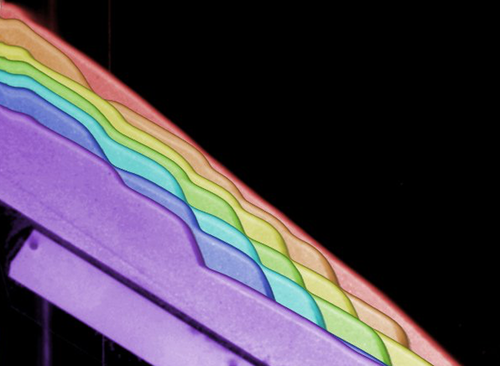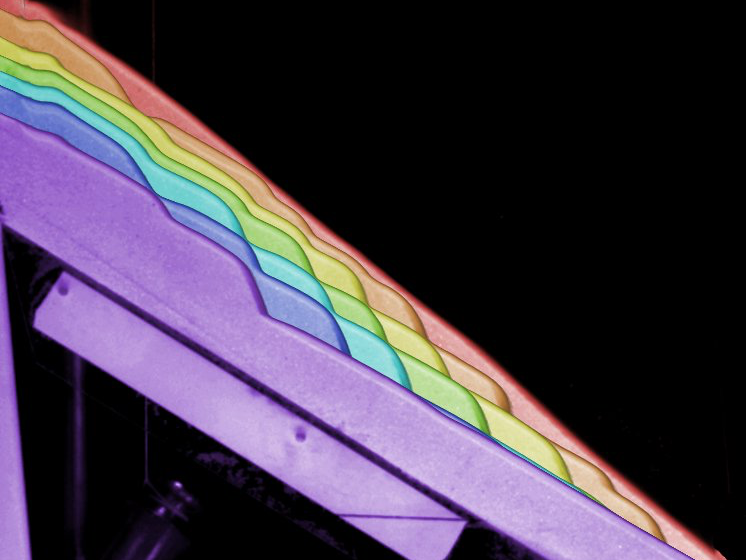Eroding Grains Step by Step
Avalanches of rocks and sand can erode a hillside just as water can, but researchers have not agreed on the mechanism of such erosion. Now experiments with glass beads suggest that the process is more fluid-like than solid-like. Researchers sent dry beads flowing over an inclined bed of wet (cohesive) beads. For high flow speeds, the stream of beads carved out a series of steps, which is a common fluid phenomenon. The results could be used to improve models that predict the risk from rockslides and similar events.
Erosion is primarily due to the flow of water, but in certain cases, granular flows can carve out 100 times more material than fluid flows [1]. A dramatic example of this is a debris flow, in which heavy rains or volcanic activity can unleash an avalanche of small rocks and other rubble. To understand these geologic events, previous lab-based experiments have typically involved pouring grains down an incline covered with a dry (loose) bed of grains. Some of these studies suggested that flowing grains act like a solid sliding block that scours the underlying bed through friction. By contrast, other researchers modeled the grains as a fluid that drives into the bed and erodes it through direct impacts, a so-called inertial effect. “It was not clear which parameters govern the erosion rate in the case of a granular flow. Is it the friction coefficient or the inertia of the flow?” says Pierre Jop from the French National Center for Scientific Research (CNRS) and the building materials company Saint-Gobain in Paris.
One way to explore granular erosion is to alter the cohesiveness of the erodible bed. In recent work, Jop and his colleagues studied granular erosion in a rotating drum, in which some of the grains were made to stick together by adding different liquids, such as water or oil [2]. The results showed that impacts played an important role in breaking the cohesive bonds.
To explore this further in a more geologically relevant setup, the team has performed experiments with dry grains flowing over a bed of wet grains. The team used glass beads with diameters in the range 200–400 micrometers for both the bed and the flowing grains. The bed beads were mixed with a small amount of water (1% by weight) and pressed into a 30-centimeter-long channel that was tilted at a steep initial angle (between 25 and 45 degrees). The team continuously poured dry beads down the slope and recorded video of the profile of the bed over the course of several hours. The flow eroded the bed until its slope reached a specific angle, the same angle that characterizes granular flow over a dry bed.
In more than half of the experimental runs, the researchers noticed that the bead surface did not remain smooth but instead formed a series of steps. This behavior is reminiscent of geologic features in river and stream channels, where the water cascades and pools to form a series of terraces in the underlying rock.
The existence of steps implies that the erosion mechanism is based on inertia and not on friction, say Jop and his colleagues. To understand the difference, imagine that a small bump (height fluctuation) forms on the surface of the bed. If friction were the dominant mechanism, then the flowing beads would grind down this bump to make the surface smooth. But instead, the fast-moving beads cascade over the bump causing the fastest erosion to occur not at the bump but at the point where the beads splash down. This erosion will grow the bump into a step, but only if the velocity of the grains is high enough (or the slope is steep enough) that the splash point occurs far from the bump.
Bruno Andreotti from the University Paris Diderot says this work addresses a central problem in granular flows: when to treat them like liquids and when to treat them like solids. He believes the new erosion model could help in assessing the risk from fast-moving debris flows (called pyroclastic flows) that are unleashed by volcanic activity.
This research is published in Physical Review Letters.
–Michael Schirber
Michael Schirber is a Corresponding Editor for Physics Magazine based in Lyon, France.
References
- J. S. Stock, D. R. Montgomery, B. D. Collins, W. E. Dietrick, and L. Sklar, “Field Measurements of Incision Rates Following Bedrock Exposure: Implications for Process Controls on the Long Profiles of Valleys Cut by Rivers and Debris Flows,” Geol. Soc. Am. Bull. 117, 174 (2005).
- G. Lefebvre and P. Jop, “Erosion Dynamics of a Wet Granular Medium,” Phys. Rev. E 88, 032205 (2013).





